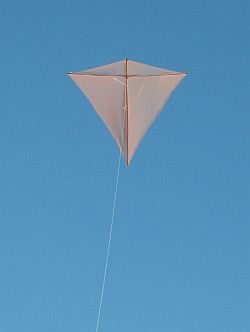- Home Page
- Flight Reports
- Sticked Diamonds
- Dowel Diamond
Dowel Diamond Kite
Flies Like a Dream in Light Wind
The Dowel Diamond kite has recently been redesigned for quicker setup and flying in very light winds. With hardly any wind outside, it seemed like a pretty good time to take the kite out. However, if I waited too long, the thermals could get a bit savage and make things interesting!
 MBK Dowel Diamond
MBK Dowel DiamondDown at the reserve, winds had already picked up a little with moderate-strength gusts rippling the tops of the gum trees.
Within a couple of minutes the diamond was rigged, attached to the 50-pound flying line, and raring to go.
It was only a moment before the first gust came through. The relatively untested diamond shot up and willingly climbed out as I quickly let out line. Being engrossed in observing the kite and getting it even higher, I just forgot the usual low-altitude photo and video session!
The Dowel Diamond kite flew well, although the increasingly strong thermal activity was starting to punish it from time to time. At least the kite was well balanced, since it didn't show a definite preference for moving off in one direction or the other.
This bridle on this new diamond is attached at two points on the horizontal spar. Hence I did not expect any of the wing waggle so typical of diamonds. Surprisingly, though, at a particular wind strength, it did start to waggle.
With even more wind speed, curvature appeared in the sail outline, and the kite started to fishtail furiously.
On this site, there's more kite-making info than you can poke a stick at. :-) Want to know the most convenient way of using it all?
The Big MBK E-book Bundle is a collection of downloads—printable PDF files which provide step-by-step instructions for many kites large and small.
That's every kite in every MBK series.
At the highest wind speeds the kite actually became more stable due to the extra billow in the sail.
The thermal activity was now forcing the kite all over the place, including a 70-degree line angle overhead! It became far too risky to let out more than about 50 meters of line. Kite-grabbing trees were everywhere past that distance! Another evidence of the very active air was when the Dowel Diamond kite suddenly lost height, just floating down on its face—sinking air. What goes up must come down somewhere else.
In between thermals, some smoother air allowed the kite to show off its light-wind capabilities.
I'm really looking forward to flying this kite in smoother and lighter conditions! After two outings, it still hasn't been to 400 feet.
With lunch time drawing near, I brought the kite down to 50 feet or so to snap off some photos.
From my previous experience with the Dowel Roller, it was clear that this diamond would benefit from a little extra weight near the bottom sail pocket. This would be at the expense of a tiny amount of light-wind performance, which would be hardly noticed. It would help prevent those long sideways excursions near the middle of its wind range, where the Dowel Diamond kite just flies along on its side and is slow to correct.
The story or stories above document actual flying experiences. My write-ups are definitely "warts and all," since things don't always go totally as planned. However, half the fun of kiting is anticipating the perfect flight. When it happens, it's magic!
As mentioned earlier, there's more kite-making info here than you can poke a stick at. :-)
Want to know the most convenient way of using it all?
The Big MBK E-book Bundle is a collection of downloads—printable PDF files which provide step-by-step instructions for many kites large and small.
That's every kite in every MBK series.
